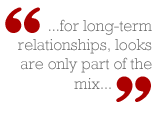







|
Matching: The Great Leveler
So you have probably wished for a good-looking date. Someone beautiful or handsome promises (according to our mythology) to be
smart, talented and fun to be with. But what about your own looks? The 1979 movie "10," starring the late comic actor
Dudley Moore, popularized informal and very subjective assessments of people's looks on a ten-point rating scale, with 1 as unattractive
and 10 as gorgeous. Moore's character, short and average-looking, lusted after the superlative looks of the beautiful Bo Derek's
character, a tragicomic fantasy the audience knows is unlikely to succeed. We know that it's not just what the other person looks like
that matters in intimacy -- it's the combination of the two people that determines whether there will be a second date.
Pretend for a moment that it's reasonable to assign objective, numerical ratings to people's looks. You fantasize about a 10. But
when you look in the mirror, do you see a 10? The vast majority of us must admit the answer is "No."
Let's say on a good day you're a 6; it's a good day, and you're out on a date with a 10! How do you feel? Lucky, sure; even a little
surprised. Show off to your friends a little: being with good-looking person leads you to Bask In Reflected Glory or "BIRG."
So you feel proud, excited and pleased. But you must also feel a little nervous -- how long can you expect to keep a 10? There
aren't many other 10's around for him or her, perhaps, but there are 9's, 8's and 7's around. Your date can do better than you, looks-wise!
So, as a 6, you feel outclassed by a 10, even an 8. But you can do better than a 4 or 5! So what level of looks do you seek in a mate so
as to feel neither insecure nor dissatisfied? Well, as a 6, you hold out for another 6! For longer-term dating and for lifelong mating,
this seems to be a common sentiment. Research confirms this in a variety of ways:
- Couples observed in natural settings are rated as significantly similar in looks.
- Video-dating customers were more likely to date other customers once or twice if they were similar in appearance.
- Husbands and wives are rated as more similar in physical attractiveness than unmarried partners.
- For couples in which one partner's level of attractiveness changes, the risk of breakup increases.
Here, then, is consolation for the majority of us who are not 10's: we can settle, and settle happily, for
partners who match us in our general level of physical attractiveness. At that point, we no longer shop "up" or "down" but
appreciate the acceptance we give and get in the matched partnership.
Trophy Wives and Other Mismatches
There are exceptions, of course: average-looking male millionaires can win drop-dead gorgeous "trophy wives" but here another type of
exchange, not a match, is going on. In exchange for his money, he gets a great-looking mate.
And self-esteem surely interacts with looks -- a person who is average-looking but confident can exude great expectations and
perhaps end up with that physically attractive partner; in contrast, a beautiful but self-deprecating person fails to seek good looks,
feeling more comfortable with someone whose looks are more average but whose other qualities are reassuring and satisfying.
Looks are valued in a culture like ours that promotes fast action and quick social judgments. But for long-term relationships and
commitments, they are only part of the mix that produces interpersonal attraction.
Who Is Good-Looking?
Thus far, this discussion has presumed some agreement about what and who is good looking. But to understand the psychology of close
relationships as well as this seminar series intends, we must examine just what it takes to be considered "good-looking" in the first
place. Two approaches should be considered -- cultural and evolutionary.
A cultural approach to physical attractiveness focuses on the many ways in which different cultures, throughout the world and
history, value different features and composites. Around the world, people might be considered physically more desirable as partners if
they are plump, to show prosperity; if their bodies have been decorated with piercings and tattoos that reflect local decorations
and symbols; or if certain body parts have been physically distorted and disabled in accordance with traditions, such as neck rings or
bound feet. The cultural approach reminds us that much of what we call good-looking is not universally recognized as such.
But an increasingly influential perspective on the power of physical attractiveness comes from evolutionary theory. From
this point of view, features and physiques are considered good-looking because they are associated with the promotion of a
species survival. In the competition to survive, individuals who have inherited certain features are "naturally" more appealing to
potential mates. This guarantees that they will produce more offspring (who inherit the same features), while those lacking the
desirable looks will be less successful in finding partners and producing progeny.
It's Evolutionary, My Dear
Charles Darwin's theory of natural selection argues that the outcome of species and features depends on both individuals'
inherited potential and the competition of the physical and social environment that "selects" in favor of some and against
others. According to evolutionary psychologist David Buss, the physical and facial features that survive this selection process are
features that will increase sexual mating and ensure the care and protection of offspring.
In concrete terms this means that males look for females that make them want to mate and who have bodies built for childbearing. Females
look for males that look capable of defending territory and kin. For both sexes, good looks are those that reflect health and strength,
looks that promise a mate who will take care of you and your children.
In most cultures studied, a man is considered attractive if he has a good -- strong, muscular -- physique but only if he is known to
possess other resources as well. From a natural-selection perspective, women find attractive those features that not only
promise good sex but also good partnering and parenting. Thus a man is more attractive if he has a good salary, economic security, the
kinds of skills that promise a safe environment for the years of child-rearing ahead. And this theory holds that such features are
compelling even among women who don't seek to bear children. Evolution builds in certain preferences, irrespective of our ability
to make up our own minds individually about what works best in our relationships.
An evolutionary explanation for specific preferences in physical appearance remains a controversial theory. Someone you don't find
immediately physically appealing can become more attractive to you as your contacts and commonalities increase. And those who seem almost
immediately physically attractive need not exert undue influence on your preferences or dominate your choices. You will find attractive
those individuals who satisfy your own strong or subtle criteria, irrespective of your agreement with cultural or inherited "standards"
of what is good-looking.
Reading Assignment
For the next session, I urge you to read Ch 5, "Love and Commitment," pp. 77-94, in our recommended text: John H. Harvey and Ann L. Weber, Odyssey of the Heart: Relationships in the 21st Century. Mahwah, NJ:
Lawrence Erlbaum Associates, 2002.

|



